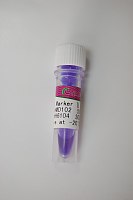Quantitative DNA Fiber Mapping in Genome Research and Construction of Physical Maps
互联网
407
Efforts to prepare a first draft of the human DNA genomic sequence forced multidisciplinary teams of researchers to face unique challenges.At the same time,these unprecedented obstacles stimulated the development of many highly innovative approaches to biomedical problem solving,robotics,and bioinformatics.High-resolution physical maps are required for ordering individual segments of information for the construction of a comprehensive map of the entire genome.This chapter describes a novel way to identify,delineate,and characterize selected,often small DNA sequences along a larger piece of the human genome.The technology is based on immobilization of high molecular weight DNA molecules on a solid substrate (such as a glass slide)followed by uniform stretching of the DNA molecule by the force of a receding meniscus.The hydrodynamic force stretches the DNA molecules homogeneously to approximately 2.3 kb/μm,so that distances measured after probe binding in μm can be converted directly into kb distances.Out of a large number of applications,this article focuses on mapping of genomic sequences relative to one another,the assembly of physical maps with near kb resolution,and,finally,quality control during physical map assembly and sequencing.









